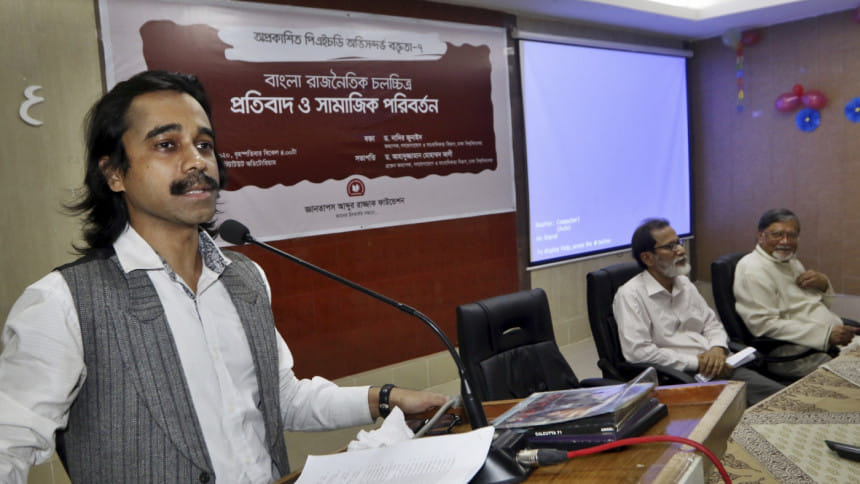Role of political cinema crucial for social change: Naadir Junaid

Cinema can provoke its audience out of passivity and into critical thought, and rather than being partisan commentary or political propaganda, the art form can help people dispel propaganda, said Prof Naadir Junaid of Dhaka University's Department of Mass Communication and Journalism yesterday.
He was speaking at a lecture series organised by Gyantapas Abdur Razzaq Foundation at the Institute of Modern Languages of DU.
This was the seventh edition of the "Distinguished Unpublished PhD Dissertation Lecture" by the nonprofit.
With political films from both sides of Bengal in focus, yesterday's lecture was titled "Bangla Political Cinema: Protest and Social Transformation".
Prof Junaid said while commercial cinema keeps people's mind away from sociopolitical reality by engaging them in "light" entertainment, political cinema does the opposite, sometimes making the audience uncomfortable through its sharp criticism of political issues, and raising political awareness.
He also acknowledged the significant role of political cinema in social movements, including the Liberation War.
The lecture zoomed in on four Bangla films: Zahir Raihan's "Jibon Theke Neya" (1970) and Tareque Masud's "Matir Moyna" (2002) from Bangladesh; and Mrinal Sen's "Calcutta 71" (1972) and Satyajit Ray's "Pratidwandi" (1970) from India's West Bengal.
All four of these use the cinematic form to provoke revolutionary vision into their audiences, Prof Junaid said.
In his paper, Prof Junaid analysed the films from various vantage points -- aesthetics, cultural and political impact, and legacy.
He also discussed the place of political cinema in the contemporary film landscape of both Bengals. "We have to ask what is the problem with our cultural climate that we can't produce movies like Ghuddi and Surja Dighal Bari that we used to have in the 80's", Prof Junaid said.
Prof Junaid lamented the lack of attention Bangla cinema gets by the international film audience, especially since many great works and directors originate from this region.
For example, works like Raihan's should occupy a significant place in world cinema canon, yet he's a virtual unknown in the anglophile world of cinema. "A portion of the blame falls on us for not being able to spread word about his work," he said.
Zahir Raihan had to employ metaphors in order to circumvent state surveillance -- as he was a marked man in the Pakistani government's eyes -- as well as social taboo.
"What Zahir Raihan had to go through to make Jibon Theke Neya, Jean-Luc Godard or Akira Kurosawa didn't have to endure," he added.
Satyajit shed his classic cinematic language -- that of "lyricism and subtlety" -- in order to raise the conscience of his audience with his "Calcutta trilogy" that started with "Pratidwandi". This he expressed not only with his plot, but with the overall aesthetics of the film, Prof Junaid observed.
Mrinal Sen employed the Brechtian fourth wall-breaking technique to unsettle the audience and provoke them into thinking more and taking a more active role in film consumption, he observed.
Tareque Masud, much like Ghatak, broke away from Western aesthetics and heavily employed rural imagery, using elements of the Baul culture and symbols such as the village mela in "Matir Moyna", to put his ideas across to the audience.
This symbolism, Prof Junaid said, is not a coincidence. "Great filmmakers don't take a single shot without purpose."
Dr Ahaduzzaman Muhammad Ali, former professor of DU's mass communication and journalism department, chaired the session.
Dr Ahrar Ahmad -- director general of Gyantapas Abdur Razzaq Foundation -- in his welcome speech spoke of the significance of Prof Junaid's paper, and of the importance of political cinema in the nurturing of a culture of critical thinking.

 For all latest news, follow The Daily Star's Google News channel.
For all latest news, follow The Daily Star's Google News channel. 



Comments